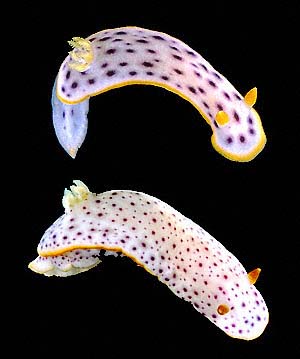
Chromodoris aspersa
(Gould, 1852)
Order: NUDIBRANCHIA
Suborder: DORIDINA
Family: Chromodorididae
DISTRIBUTION
Known throughout the tropical Indo-West Pacific.
PHOTO
UPPER: Undine Reef, southern Great Barrier Reef, Queensland, August 1987.
LOWER: Arrawarra headland, northern New South Wales, intertidal, March 1992.
Photos: Bill Rudman.
References:
• Rudman, W.B. (1983) The Chromodorididae (Opisthobranchia: Mollusca) of the Indo-West Pacific: Chromodoris splendida, C. aspersa and Hypselodoris placida colour groups. Zoological Journal of the Linnean Society, 78: 105-173.
• Gould, A.A. (1852). United States Exploring Expedition during the years 1838-1842. Mollusca and Shells, 12: 510 pp (with Atlas of Plates, 1856.
Authorship detailsRudman, W.B., 1998 (June 11) Chromodoris aspersa (Gould, 1852). [In] Sea Slug Forum. Australian Museum, Sydney. Available from http://www.seaslugforum.net/find/chraspe
Related messages
Chromodoris aspersa from Reunion Island
June 8, 2007
From: Hugues Flodrops
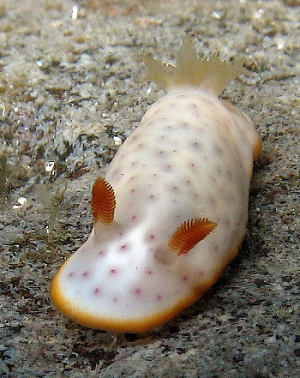
Concerning message #9513:
Dear Bill,
Here is a record from Reunion Is of what I believe is Chromodoris aspersa. It was found at night. There is on the left of the photo a kind of worm?
Locality: Etang-Salé, 1 metre, Reunion Island, Indian Ocean, 16 april 2007, Night. Length: 20 mm. Photographer: Hugues Flodrops.
Best regards,
Hugues Flodrops.
hugues.flodrops@wanadoo.fr
Flodrops, H., 2007 (Jun 8) Chromodoris aspersa from Reunion Island. [Message in] Sea Slug Forum. Australian Museum, Sydney. Available from http://www.seaslugforum.net/find/19958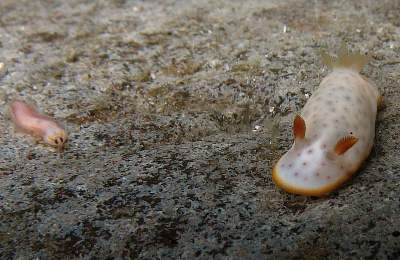
Dear Hugues,
Yes this is C. aspersa. The purple spots, each surrounded by a zone of translucent purple, is a unique character of this species.
I am not an expect on polychaete worms but I am pretty sure this is the 'heteronereid' stage of a nereid worm. At breeding time many nereid worms change shape or grow new sections of their body with enlarged parapodia and setae, enlarged eyes, luminescent bodies, and are packed full of ripe eggs or sperm. At night they swarm to the surface to release all their gametes into the water. Some species are very synchronised, millions of individuals swarming at the same time to turn the water milky with the gametes. The sexual stage is known as a heteronereid because when the first one was found its true nature was not known and it was named as a new species in a new genus Heteronereis.
Best wishes,
Bill Rudman
Chromodoris aspersa from Myanmar
March 31, 2003
From: Mary Jane Adams
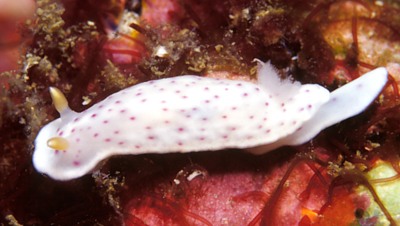
Hi Bill,
I think this is Chromodoris aspersa. I photographed it at Western Rocky, Mergui Archipelago, Andaman Sea, Myanmar on Feb. 25, 2003.
Length of notum: 20mm.
Best regards,
Mary Jane
divepng@yahoo.com
Adams, M.J., 2003 (Mar 31) Chromodoris aspersa from Myanmar. [Message in] Sea Slug Forum. Australian Museum, Sydney. Available from http://www.seaslugforum.net/find/9513Thanks Mary Jane,
Despite the lack of a yellow border I agree this is most likely to be C. aspersa. The pale 'washy purple' ring around each purple spot is very characteristic of this species.
Best wishes,
Bill Rudman
Chromodoris aspersa from Lord Howe Island
January 10, 2003
From: W.B. Rudman
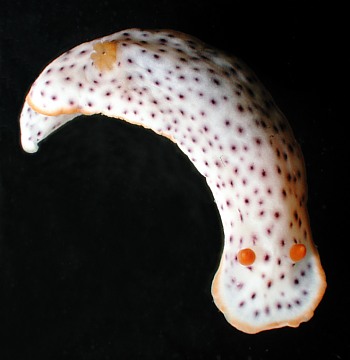
Here is a photo record from Ian Hutton of Chromodoris aspersa from Lord Howe Island.
Bill Rudman
Rudman, W.B., 2003 (Jan 10) Chromodoris aspersa from Lord Howe Island. [Message in] Sea Slug Forum. Australian Museum, Sydney. Available from http://www.seaslugforum.net/find/8826Chromodoris aspersa from the Red Sea
February 1, 2001
From: Gordon T. Smith
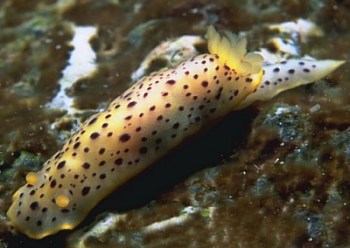
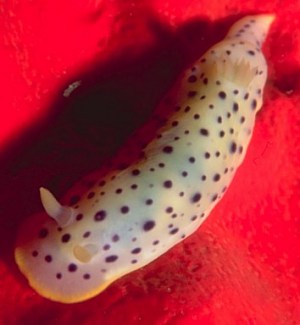
Dear Bill,
Could you verify identification of these nudibranchs which I believe to be Chromodoris aspersa. Photographed in the Red Sea, size and depth unrecorded.
Regards
Gordon
aquashot@emirates.net.ae
Smith, G.T., 2001 (Feb 1) Chromodoris aspersa from the Red Sea. [Message in] Sea Slug Forum. Australian Museum, Sydney. Available from http://www.seaslugforum.net/find/3652Dear Gordon,
Yes this is a colour form of C. aspersa which seems restricted to the Red Sea. Gohar & Soliman (1967) illustrate it from Egypt and I have studied specimens from the Sudan (Rudman, 1983). It differs from the typical Indo-West Pacific form in having larger and slightly raised purple spots. The diffuse ring surrounding each spot is much less obvious in Red Sea specimens. I compared the anatomy of Red Sea and Indo-West Pacific animals some time ago and could find no distinctive differences.
Reference:
• Rudman, W.B. (1983) The Chromodorididae (Opisthobranchia: Mollusca) of the Indo-West Pacific: Chromodoris splendida, C. aspersa and Hypselodoris placida colour groups. Zoological Journal of the Linnean Society, 78: 105-173.
Best wishes,
Bill Rudman
Chromodoris aspersa from French Polynesia
December 24, 2000
From: Daniel L. Geiger
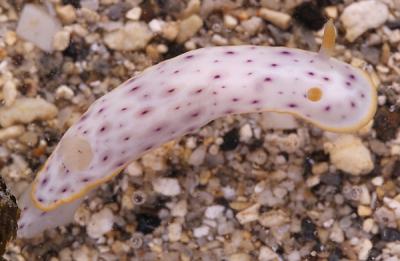
Dear Bill,
Here is another nudibranch from Rangiroa, French Polynesia. it was was ID-ed by Erwin Köhler as Chromodoris aspersa (?). Again, specimens are available for molecular work.
Daniel
dgeiger@nhm.org
Geiger, D.L., 2000 (Dec 24) Chromodoris aspersa from French Polynesia. [Message in] Sea Slug Forum. Australian Museum, Sydney. Available from http://www.seaslugforum.net/find/3401Thanks Daniel,
Yes this is C. aspersa.
Bill Rudman.
Chromodoris aspersa from South Africa
March 2, 2000
From: Valda Fraser
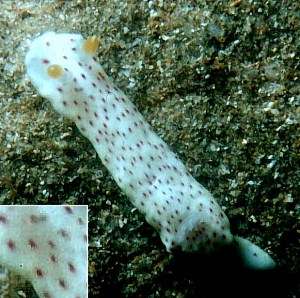
Dear Bill
I think this is a Mexichromis. I hope you will be able to identify it.
Locality: South Coast KwaZulu-Natal SOUTH AFRICA. Shelly Beach - 32m
Date: 27 Feb 2000
Size: 26mm
Regards
Valda Fraser
iti04937@mweb.co.za
Fraser, V., 2000 (Mar 2) Chromodoris aspersa from South Africa. [Message in] Sea Slug Forum. Australian Museum, Sydney. Available from http://www.seaslugforum.net/find/1993Dear Valda,
Your mention of Mexichromis reminds me I have some Mexichromis photos of yours to sort out. This animal though is not Mexichromis. It is Chromodoris aspersa. Sometimes you find individuals without the yellow/orange mantle border but otherwise they are identical anatomically. It does not seem to be a geographic thing because I have found pale ones in Tanzania and eastern Australia.
One good colour feature of this species is the washy or diffuse ring of purple that surrounds each purple spot [see inset].
Best wishes,
Bill Rudman.
Chromodoris from Kerama Island
June 2, 1999
From: Atsushi Ono

How do you do,
Dr.Bill Rudman.
My name is Atsushi Ono. I Have been collecting Opisthobranch photos at Kerama Is. near Okinawa Is. Your site The Sea Slug Forum is very useful, I visit 2 or 3 times a week. But I am not good at English.
I'm sorry for my poor English. So that Ms. Rie Nakano sent you my photographs and asked ID before.
This time, I try to write English by myself.
Please help me with some some Opisthobranch names.
I think this is Chromodoris sp.
7m depth, under dead coral rubble, 8mm length. April 1999.
Sincereiy,
Atsushi Ono
ononini@cosmos.ne.jp
Ono, A., 1999 (Jun 2) Chromodoris from Kerama Island. [Message in] Sea Slug Forum. Australian Museum, Sydney. Available from http://www.seaslugforum.net/find/906Dear Atsushi,
Don't worry about your English. Your good photos don't need many words!
I can't be 100% sure without a specimen, but I think this is a juvenile of Chromodoris aspersa. It is the only species I know with the diffuse purple ring around each purple spot. The lack of a yellow mantle border is not necessarily a problem as juvenile chromodorids often don't develop their coloured borders until they are quite large.
Best wishes,
Bill Rudman.
Chromodoris aspersa?
June 11, 1998
From: Wayne Ellis
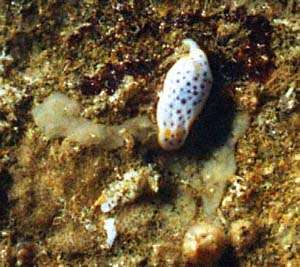
Hi Bill,
Attached is a pic of what I believe is Chromodoris aspersa. (Gould 1852). Can you confirm it? Found by Robyn Oxenham at Point Cartwright, Moloolaba, Sunshine Coast, Southern Queensland, (26041'S 153008'E) on 24 May 1998 at low tide under a rock. Size 12mm
Regards
Wayne
Wayne Ellis
glaskin@ozemail.com.au
Ellis, W., 1998 (Jun 11) Chromodoris aspersa?. [Message in] Sea Slug Forum. Australian Museum, Sydney. Available from http://www.seaslugforum.net/find/38Yes its Chromodoris aspersa. The border varies in colour from pale yellow to almost orange in different animals. The number of spots varies considerably. One very characteristic feature is that the purple spots are usually edged with a band of faint washy purple.. like a drop of water paint or ink on wet paper. ... Bill Rudman
Rudman, W.B., 1998 (Jun 11). Comment on Chromodoris aspersa? by Wayne Ellis. [Message in] Sea Slug Forum. Australian Museum, Sydney. Available from http://www.seaslugforum.net/find/38